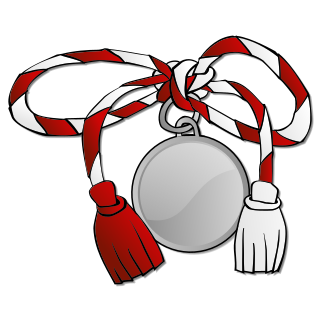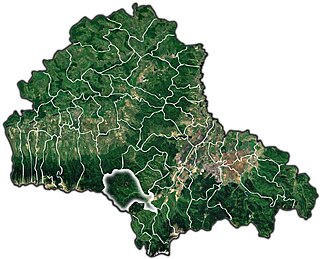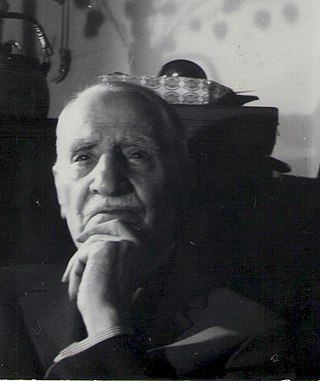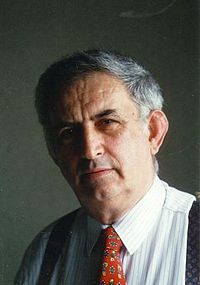Related Research Articles

The ney, is an end-blown flute that figures prominently in Persian music, Turkish music and Arabic music. In some of these musical traditions, it is the only wind instrument used. The ney has been played continually for 4,500–5,000 years in ancient Egypt, making it one of the oldest musical instruments still in use.

The Romanian alphabet is a variant of the Latin alphabet used for writing the Romanian language. It is a modification of the classical Latin alphabet and consists of 31 letters, five of which have been modified from their Latin originals for the phonetic requirements of the language:

Mărțișor is the Romanian name of a tradition celebrated at the beginning of spring, in the month of March, and the name of the associated object made from two intertwined red and white strings with hanging tassel in Romania and Moldova, very similar to Martenitsa tradition in Bulgaria and Martinka in North Macedonia and traditions of other populations from Southeastern Europe.

Zărnești is a town in Brașov County, Transylvania, Romania, with a population of 21,681. It administers one village, Tohanu Nou.

Ciolpani is a commune in the northwestern part of Ilfov county, Muntenia, Romania. It is composed of five villages: Ciolpani, Izvorani, Lupăria, Piscu and Țigănești.

King Michael I Park, formerly Herăstrău Park, is a large park on the northern side of Bucharest, Romania, around Lake Herăstrău, one of the lakes formed by the Colentina River.

Dicționarul explicativ al limbii române is the most important dictionary of the Romanian language, published by the Institute of Linguistics of the Romanian Academy.
The lexis of the Romanian language, a Romance language, has changed over the centuries as the language evolved from Vulgar Latin, to Common Romanian, to medieval, modern and contemporary Romanian. A large proportion of present-day Romanian lexis is not inherited from Latin and in some semantic areas loanwords far outnumber inherited ones making Romanian an example of a language with a high degree of lexical permeability.
This is a glossary of historical Romanian ranks and titles used in the principalities of Moldavia, Wallachia and Transylvania, and later in Romania. Many of these titles are of Slavic etymology, with some of Greek, Latin, and Turkish etymology; several are original. Various boier titles correspond to various honorary services at the Court, but often they were associated with various actual governmental duties as well.

Iorgu Iordan was a Romanian linguist, philologist, diplomat, journalist, and left-wing agrarian, later communist, politician. The author of works on a large variety of topics, most of them dealing with issues of the Romanian language and Romance languages in general, he was elected a full member of the Romanian Academy in 1945. He was head of its Institute of Linguistics between 1949 and his retirement in 1962.
The Romanian calendar is the Gregorian, adopted in 1919. However, the traditional Romanian calendar has its own names for the months. In modern Romania and Moldova, the Gregorian calendar is exclusively used for business and government transactions and predominates in popular use as well. Nevertheless, the traditional names of the months do appear in some contexts, for instance on ecclesiastical calendars produced by the Romanian Orthodox Church.
The spatharii or spatharioi were a class of Late Roman imperial bodyguards in the court in Constantinople in the 5th–6th centuries, later becoming a purely honorary dignity in the Byzantine Empire.

Laura Pavel is a Romanian essayist and literary critic.
Silviu Berejan was a Romanian philologist, lexicologist and linguist from Bessarabia, one of the titular members of the Academy of Sciences of Moldova, the romance linguistic specialty and Slavic, principal scientist at the Institute of Linguistics of the Academy of Sciences of Moldova.
Păcuiul lui Soare is an island on the Danube in southeastern Romania, known for its Bulgarian and Byzantine fortress, built in the 8th century and abandoned by the 15th century.

St. Theodora of Sihla is a Romanian Christian Orthodox saint, commemorated on August 7.
A knez or kenez was a leader of the Vlach (Romanian) communities in the Kingdom of Hungary and western Balkans, during the Middle Ages.
The longest word in the Romanian language is pneumonoultramicroscopicsilicovolcaniconioză, the long name of silicoză (silicosis). It consists of 44 letters and refers to a chronic respiratory disease. Its name in the English language is pneumonoultramicroscopicsilicovolcanoconiosis and it is the longest English word registered on a major English dictionary. Nevertheless, neither this word nor several subsequent Romanian longest words are recognized by the Dicționarul explicativ al limbii române. Instead, the longest word collected by the DEX is electroglotospectrografie, which is a medical stabilization method, has 25 letters and comes from the French word électroglottospectrographie.

Marius Sala was a Romanian linguist, member of the Romanian Academy. His activity gained international academic recognition in the study of Romance languages.
References
- ↑ "albinărit". Dicționarul explicativ al limbii române (in Romanian). Academia Română, Institutul de Lingvistică "Iorgu Iordan", Editura Univers Enciclopedic. 1988.
- ↑ "stupărit". Dicționarul explicativ al limbii române (in Romanian). Academia Română, Institutul de Lingvistică "Iorgu Iordan", Editura Univers Enciclopedic. 1988.
- ↑ "prisăcărit". Dicționarul explicativ al limbii române (in Romanian). Academia Română, Institutul de Lingvistică "Iorgu Iordan", Editura Univers Enciclopedic. 1988.
- ↑ "cotărit". Dicționarul explicativ al limbii române (in Romanian). Academia Română, Institutul de Lingvistică "Iorgu Iordan", Editura Univers Enciclopedic. 1988.
- ↑ "căldare". Dicționarul explicativ al limbii române (in Romanian). Academia Română, Institutul de Lingvistică "Iorgu Iordan", Editura Univers Enciclopedic. 1988.
- ↑ "cepărit". Dicționarul explicativ al limbii române (in Romanian). Academia Română, Institutul de Lingvistică "Iorgu Iordan", Editura Univers Enciclopedic. 1988.
- ↑ "cerărit". Dicționarul explicativ al limbii române (in Romanian). Academia Română, Institutul de Lingvistică "Iorgu Iordan", Editura Univers Enciclopedic. 1988.
- ↑ "cocărit". Dicționarul explicativ al limbii române (in Romanian). Academia Română, Institutul de Lingvistică "Iorgu Iordan", Editura Univers Enciclopedic. 1988.
- ↑ "dijmărit". Dicționarul explicativ al limbii române (in Romanian). Academia Română, Institutul de Lingvistică "Iorgu Iordan", Editura Univers Enciclopedic. 1988.
- ↑ "folărit". Dicționarul explicativ al limbii române (in Romanian). Academia Română, Institutul de Lingvistică "Iorgu Iordan", Editura Univers Enciclopedic. 1988.
- ↑ "fumărit". Dicționarul explicativ al limbii române (in Romanian). Academia Română, Institutul de Lingvistică "Iorgu Iordan", Editura Univers Enciclopedic. 1988.
- ↑ "coșărit". Dicționarul explicativ al limbii române (in Romanian). Academia Română, Institutul de Lingvistică "Iorgu Iordan", Editura Univers Enciclopedic. 1988.
- ↑ "ierbărit". Dicționarul explicativ al limbii române (in Romanian). Academia Română, Institutul de Lingvistică "Iorgu Iordan", Editura Univers Enciclopedic. 1988.
- 1 2 "jugărit". Dicționarul explicativ al limbii române (in Romanian). Academia Română, Institutul de Lingvistică "Iorgu Iordan", Editura Univers Enciclopedic. 1988.
- ↑ "măjărit". Dicționarul explicativ al limbii române (in Romanian). Academia Română, Institutul de Lingvistică "Iorgu Iordan", Editura Univers Enciclopedic. 1988.
- ↑ "morărit". Dicționarul explicativ al limbii române (in Romanian). Academia Română, Institutul de Lingvistică "Iorgu Iordan", Editura Univers Enciclopedic. 1988.
- ↑ "oierit". Dicționarul explicativ al limbii române (in Romanian). Academia Română, Institutul de Lingvistică "Iorgu Iordan", Editura Univers Enciclopedic. 1988.
- ↑ "perperit". Dicționarul explicativ al limbii române (in Romanian). Academia Română, Institutul de Lingvistică "Iorgu Iordan", Editura Univers Enciclopedic. 1988.
- ↑ "pădurărit". Dicționarul explicativ al limbii române (in Romanian). Academia Română, Institutul de Lingvistică "Iorgu Iordan", Editura Univers Enciclopedic. 1988.
- ↑ "podărit". Dicționarul explicativ al limbii române (in Romanian). Academia Română, Institutul de Lingvistică "Iorgu Iordan", Editura Univers Enciclopedic. 1988.
- ↑ "pogonărit". Dicționarul explicativ al limbii române (in Romanian). Academia Română, Institutul de Lingvistică "Iorgu Iordan", Editura Univers Enciclopedic. 1988.
- ↑ "popărit". Dicționarul explicativ al limbii române (in Romanian). Academia Română, Institutul de Lingvistică "Iorgu Iordan", Editura Univers Enciclopedic. 1988.
- ↑ "săpunărit". Dicționarul explicativ al limbii române (in Romanian). Academia Română, Institutul de Lingvistică "Iorgu Iordan", Editura Univers Enciclopedic. 1988.
- ↑ "solărit". Dicționarul explicativ al limbii române (in Romanian). Academia Română, Institutul de Lingvistică "Iorgu Iordan", Editura Univers Enciclopedic. 1988.
- ↑ "tescovinărit". Dicționarul explicativ al limbii române (in Romanian). Academia Română, Institutul de Lingvistică "Iorgu Iordan", Editura Univers Enciclopedic. 1988.
- ↑ "țigănărit". Dicționarul explicativ al limbii române (in Romanian). Academia Română, Institutul de Lingvistică "Iorgu Iordan", Editura Univers Enciclopedic. 1988.
- ↑ "tutunărit". Dicționarul explicativ al limbii române (in Romanian). Academia Română, Institutul de Lingvistică "Iorgu Iordan", Editura Univers Enciclopedic. 1988.
- ↑ "văcărit". Dicționarul explicativ al limbii române (in Romanian). Academia Română, Institutul de Lingvistică "Iorgu Iordan", Editura Univers Enciclopedic. 1988.
- ↑ "cornărit". Dicționarul explicativ al limbii române (in Romanian). Academia Română, Institutul de Lingvistică "Iorgu Iordan", Editura Univers Enciclopedic. 1988.
- ↑ "sulgiu". Dicționarul explicativ al limbii române (in Romanian). Academia Română, Institutul de Lingvistică "Iorgu Iordan", Editura Univers Enciclopedic. 1988.
- ↑ "vădrărit". Dicționarul explicativ al limbii române (in Romanian). Academia Română, Institutul de Lingvistică "Iorgu Iordan", Editura Univers Enciclopedic. 1988.
- ↑ "vinărit". Dicționarul explicativ al limbii române (in Romanian). Academia Română, Institutul de Lingvistică "Iorgu Iordan", Editura Univers Enciclopedic. 1988.
- ↑ "vinărici". Dicționarul explicativ al limbii române (in Romanian). Academia Română, Institutul de Lingvistică "Iorgu Iordan", Editura Univers Enciclopedic. 1988.
- ↑ "pivnicerit". Dicționarul explicativ al limbii române (in Romanian). Academia Română, Institutul de Lingvistică "Iorgu Iordan", Editura Univers Enciclopedic. 1988.
- ↑ "otaștină". Dicționarul explicativ al limbii române (in Romanian). Academia Română, Institutul de Lingvistică "Iorgu Iordan", Editura Univers Enciclopedic. 1988.